The Alchemy of the Block: A Masterclass in Crafting the High-Quality Instant Noodle Brick
The instant noodle. A universal symbol of convenience, a staple of dorm rooms and busy households, and a culinary canvas for cultures across the globe. For many, it is a simple, utilitarian food: a vehicle for flavor packets, designed for speed and satiety. Yet, within that seemingly simple, folded block of noodles lies a world of profound complexity, where food science, material engineering, and culinary artistry converge. The quality of the final bowl of soup is overwhelmingly determined long before the hot water is poured—it is locked into the very structure of the noodle block itself.
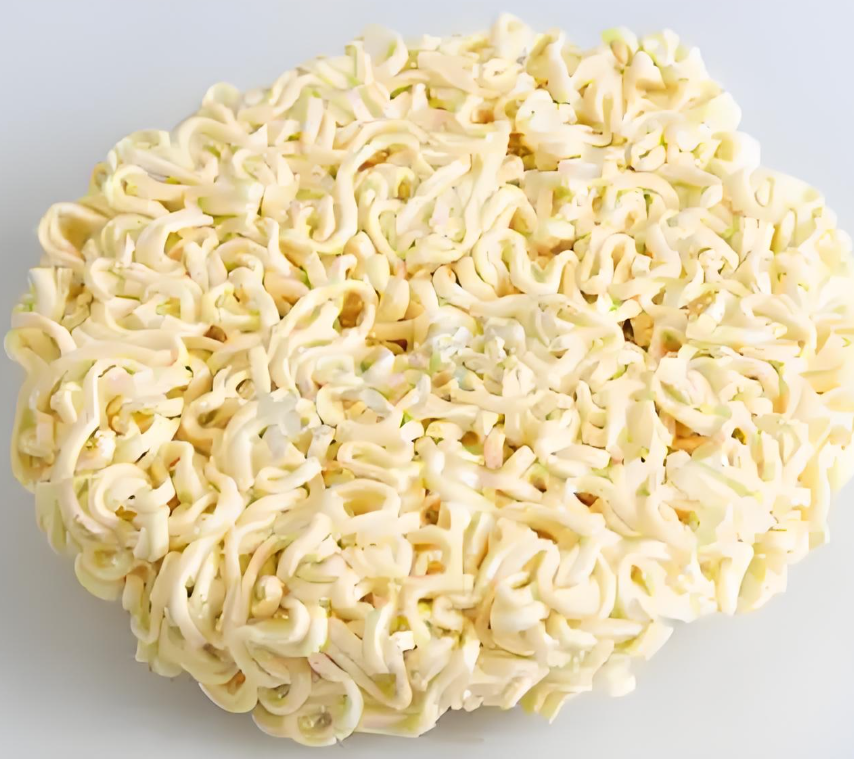
To craft a high-quality instant noodle block is to master a multi-faceted discipline. It is a pursuit that moves far beyond the industrial paradigm of cost-minimization Instant noodle making machine and shelf-life maximization, and into the realm of texture, mouthfeel, aroma, and structural integrity. This article will dissect this process into six fundamental, interlocking pillars, providing a masterclass in the creation of a superior noodle brick.
- The Foundation: Flour Selection and Specification
- The Dough Matrix: Hydration, Alkali, and Gluten Development
- The Architecture of the Noodle: Sheeting, Laminating, and Cutting
- The First Transformation: Steaming and Starch Gelatinization
- The Preservation Crossroads: Frying vs. Air-Drying
- The Final Act: Cooling, Stabilization, and Packaging
Understanding and mastering each of these stages is the difference between a noodle that is merely reconstituted and one that is reborn—a noodle with spring, bite, flavor, and soul.
Pillar 1: The Foundation: Flour Selection and Specification
The journey to a high-quality noodle block begins not in a factory, but in a field. The choice of flour is the single most critical decision a noodle craftsman can make. It is the primary structural component, the source of the noodle’s protein network, and the canvas upon which all other processes will paint. For a high-quality product, one cannot simply use generic “bread flour” or “all-purpose flour.” Precision is paramount.
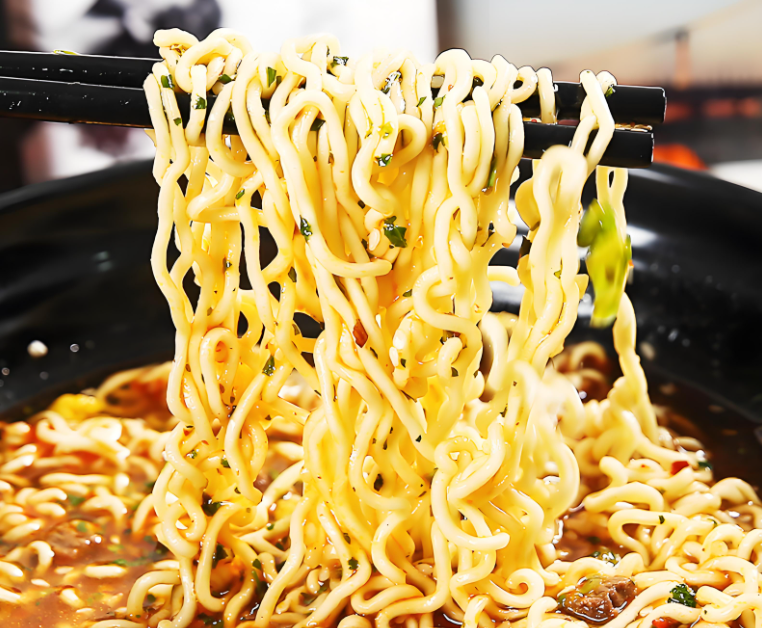
The Paramount Importance of Protein
The protein content of wheat flour, which forms gluten when hydrated, is the primary determinant of a noodle’s texture.
- The Role of Gluten: Gluten is a viscoelastic network of proteins (glutenin and gliadin) that gives dough its strength and extensibility. In a finished noodle, a strong, continuous gluten network provides the coveted “bite” or “al dente” quality—known as koshi in Japanese or dao in Chinese. It is the springy, chewy resilience that resists the teeth slightly before yielding.
- Protein Percentage Targeting: For a high-quality instant noodle, a protein content between 11.5% and 13.5% is typically the target range. Flours in this range, often classified as “high-gluten” or “patent” flours, provide sufficient structural integrity to withstand the intense mechanical stress of sheeting and cutting, as well as the thermal shocks of steaming and frying or drying. A protein content below 11% may result in a soft, mushy noodle that lacks bite and falls apart easily. A content significantly above 14% can lead to a noodle that is overly tough, hard to rehydrate, and can have a rubbery, unpleasant mouthfeel.
Protein Quality Over Quantity
However, protein content is not the whole story. The quality of the protein is equally, if not more, important. Two flours with identical protein percentages can behave drastically differently based on the wheat variety, growing conditions, and milling process.
- Glutenin/Gliadin Ratio: Glutenin provides elasticity (the ability to spring back), while gliadin provides extensibility (the ability to stretch). An ideal noodle flour has a balanced ratio, allowing the dough to be rolled thin without snapping back excessively, yet strong enough to hold its structure. Modern milling and wheat breeding allow for the selection of flours with specific functional properties.
- The Falling Number Test: This test measures the alpha-amylase enzyme activity in the flour. Excessive enzyme activity (a low Falling Number) can break down starch into sugars, leading to a sticky, gummy dough and a noodle that becomes soft and turbid in the soup. A high Falling Number (low enzyme activity) is desirable for instant noodles, ensuring starch stability during processing.
The Science of Starch
While protein provides the skeleton, starch is the flesh. The starch granules, embedded within the gluten network, are responsible for the noodle’s texture, surface smoothness, and water absorption.
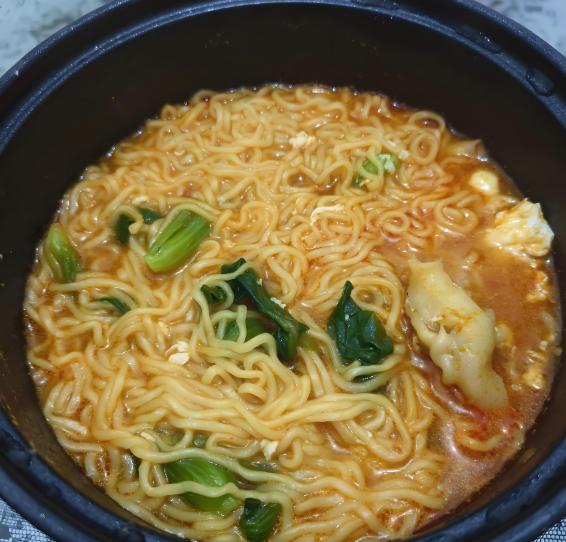
- Starch Granule Integrity: Undamaged starch granules are ideal. During milling, some starch granules can be physically damaged. Damaged starch absorbs water rapidly and can lead to a soft, weak dough. A high-quality flour will have a low percentage of damaged starch.
- The Amylose/Amylopectin Ratio: Wheat starch is composed of two polymers: amylose (a largely linear molecule) and amylopectin (a highly branched molecule). The ratio between them affects the gelatinization and retrogradation behavior of the noodle. A higher amylose content is often associated with a firmer, less sticky noodle texture after cooking and cooling.
Alternative Flours and Blends
The pursuit of quality can also involve innovation. Instant noodle making machine Some artisanal producers incorporate alternative flours to create unique textures, flavors, or nutritional profiles.
- Whole Wheat Flour: Adds a nutty flavor and dietary fiber but introduces bran particles that can sever the gluten network, resulting in a weaker, more brittle noodle. This can be mitigated by using very fine whole wheat flour or a low-percentage blend.
- Spelt or Rye: These can contribute interesting, earthy flavors but have different gluten-forming properties, requiring significant formulation adjustments.
- Starch Additions: Purified starches from tapioca, potato, or corn are sometimes added in small quantities (2-5%) to modify texture. They can increase the noodle’s translucency, give it a smoother, glossier surface, and create a slightly softer, more yielding bite.
Flour Aging and Conditioning
Freshly milled flour is not ideal for noodle-making. It requires a period of “aging,” typically several weeks, through natural oxidation. Instant noodle making machine This process strengthens the gluten-forming potential. In industrial settings, this is accelerated with maturing agents like ascorbic acid or azodicarbonamide. For the highest quality, natural aging is preferred to avoid any chemical aftertastes.
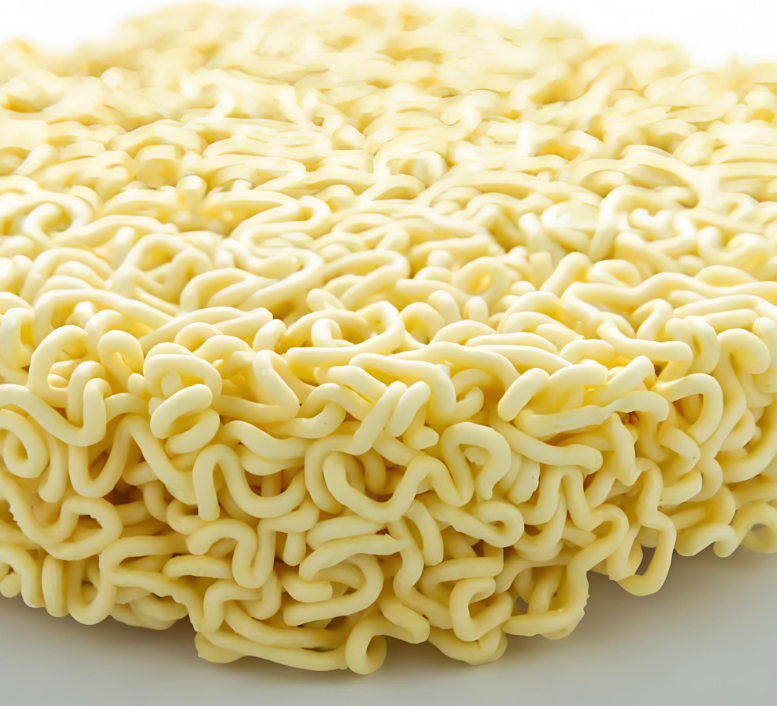
In conclusion, the foundation of a great noodle block is a meticulously specified, high-protein, high-quality wheat flour with a balanced gluten strength, stable starch, and minimal enzymatic activity. It is the non-negotiable starting point for all that follows.
Pillar 2: The Dough Matrix: Hydration, Alkali, and Gluten Development
With the perfect flour selected, the next step is to animate it—to transform a dry powder into a cohesive, viscoelastic dough. This is a delicate ballet of chemistry and physics, where the precise control of ingredients and mechanical energy creates the matrix that will define the noodle’s soul.
The Science of Hydration
The amount of water added to the flour is expressed as a percentage of the flour’s weight. This hydration level is a master variable controlling dough rheology and final texture.
- Low Hydration (28-32%): Common in many traditional and industrial processes. This creates a very stiff, crumbly dough that is difficult to mix but results in an extremely firm, dense, and chewy noodle. It requires powerful machinery and is prone to creating uneven hydration if not mixed thoroughly.
- The Artisanal Sweet Spot (33-38%): For a high-quality, small-batch noodle, this range is often ideal. It provides enough water to fully hydrate the protein and starch, allowing for the development of a strong but not overly tough gluten network. The dough is pliable and smooth, making it easier to sheet evenly without excessive stress. The final noodle strikes a perfect balance: elastic and springy, yet tender.
- High Hydration (39%+): This is the domain of fresh pasta like Udon or certain Italian styles. The dough is very soft and sticky, challenging to handle on automated lines. While it can yield a uniquely soft, silken texture, it is less suitable for instant noodles as it can lead to excessive sticking during processing and a noodle that may become too soft upon rehydration.Instant noodle making machine
Water Quality and Temperature
The mineral content of the water (hardness) can subtly interact with the gluten proteins and should be consistent. More critically, water temperature is a key control parameter.
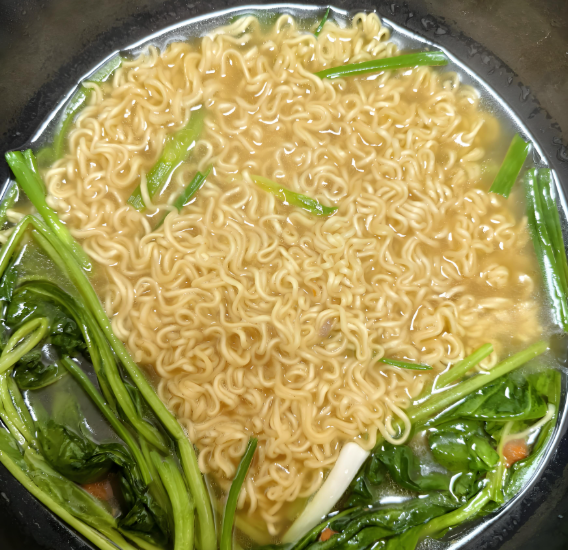
- The Case for Cold Water: Using chilled water (typically between 10°C and 15°C / 50°F and 59°F) is a best practice for quality. Cold water has several benefits:
- It slows the hydration of the gluten proteins, allowing for a more even and controlled development during mixing.
- It inhibits the activity of naturally occurring enzymes in the flour that can break down starch and protein.
- It prevents the dough from becoming too elastic and “bucky,” which would make it difficult to sheet and result in excessive spring-back.
Kansui: The Alkaline Alchemist
For the distinctive bite and flavor of Asian-style noodles, the secret weapon is kansui (枧水). This is not a single ingredient but a blend of alkaline salts, traditionally potassium carbonate (K₂CO₃) and sodium carbonate (Na₂CO₃).
The addition of kansui, typically between 0.5% and 1.5% of the flour weight, triggers a series of chemical transformations:
- pH Elevation and Flavor: The raised pH (typically to 9-11) imparts the characteristic “eggy,” slightly sharp, and complex flavor that defines ramen and similar noodles. It neutralizes the slightly sour notes of wheat, allowing other flavors to shine.Instant noodle making machine
- Gluten Strengthening: In an alkaline environment, the gluten network undergoes a change. The disulfide bonds within the glutenin proteins are disrupted, allowing the proteins to unfold and form a denser, more cross-linked network. This results in a noodle that is significantly firmer, more elastic, and less sticky.
- Starch Modification: Alkali causes the starch granules to swell and gelatinize at a lower temperature. This is crucial for the subsequent steaming step, allowing the noodle to set and cook through more efficiently without becoming mushy.
- Color Development: Kansui reacts with the flavonoids naturally present in the flour, producing a beautiful, appetizing yellowish color.
- Microbial Inhibition: The high pH creates an environment less hospitable to mold and bacteria, acting as a natural preservative.
The exact ratio of potassium to sodium carbonate is a matter of artistry. Potassium carbonate is often credited with providing a stronger, more translucent noodle with a better bite, while sodium carbonate contributes more to the color and classic alkaline flavor. Small-batch producers often experiment with this ratio to create a signature texture.
The Mixing and Kneading Process: Building the Structure
Mixing is not merely about combining ingredients; it is about developing the gluten network through mechanical work. The process occurs in distinct stages:
- Hydration Stage (Slow Speed): The initial mixing at low speed ensures all flour particles are uniformly wetted without forming large lumps. This stage is critical for consistency; dry pockets of flour will create weak spots in the final noodle sheet.
- Development Stage (High Speed): Once hydrated, the mixer is switched to a higher speed. The mechanical action aligns the glutenin and gliadin proteins, allowing them to cross-link and form a continuous, three-dimensional network. This is where the dough transforms from a shaggy mass into a smooth, cohesive ball.
- The Windowpane Test: A classic test for gluten development is to take a small piece of dough and gently stretch it. If a thin, translucent membrane can be formed without tearing, the gluten is sufficiently developed. If it tears easily, it requires more mixing.
The Critical Resting Period (Autolyse)
After mixing, the dough is not immediately ready for sheeting. It must rest, typically for 15 to 30 minutes. This “autolyse” period is deceptively simple but vitally important.
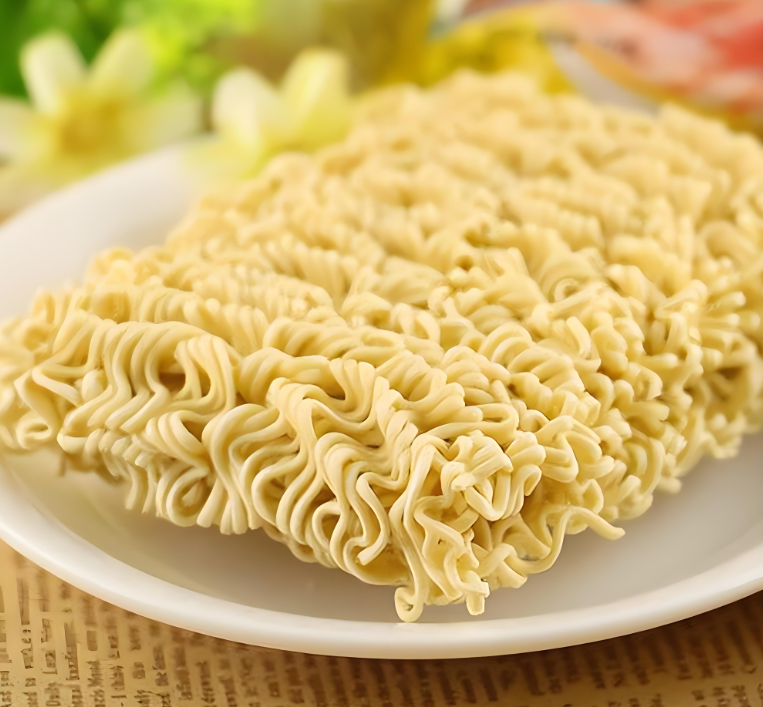
- During the rest, water fully and evenly hydrates every part of the flour, including the starch granules.
- The gluten network, stressed and tense from mixing, relaxes. This reduces its elasticity, making the dough much more pliable and extensible for the sheeting process. Attempting to sheet an un-rested dough will result in excessive spring-back, tearing, and an uneven thickness.
The perfectly mixed and rested dough is smooth, slightly warm from mechanical friction, and possesses a silky, pliable quality—a promise of the texture to come.
Pillar 3: The Architecture of the Noodle: Sheeting, Laminating, and Cutting
The rested dough is a unified mass, but it is not yet a noodle. This stage is about geometry and physics—transforming the amorphous dough into a thin, uniform sheet, and then into thousands of identical strands with a specific shape and texture. This is where the noodle’s final architecture is defined.
The Laminating Sheeter: The Heart of the Operation
Small-batch and artisanal producers typically use a laminating sheeter, a machine with a series of consecutive rollers, each pair set closer together than the last.
- Initial Dough Breaking: The dough ball is first passed through a set of large, grooved rollers. These “dough breakers” compress the mass into a thick, ragged sheet and begin the initial alignment of the gluten network.
- The Power of Lamination (Folding): This is the single most important step for creating a noodle with superior bite and texture. The thick sheet is folded over itself—usually in half or into thirds—and fed back through the same rollers. This process is repeated multiple times.
- The Science of Lamination: Each fold creates a new layer, forcing the gluten network to align in parallel sheets, much like the layers in puff pastry or laminated dough. This layered structure is what gives hand-pulled noodles their incredible elasticity and chewy texture. By replicating this process mechanically, we build a strong, directional gluten network that results in a noodle with exceptional koshi (springiness).
- Gradual Reduction: After sufficient lamination (typically 5-10 folds), the sheet begins its journey through the progressive rollers. The gap between each successive roller pair is precisely calibrated to reduce the sheet’s thickness gradually. A sudden, large reduction would shear and tear the carefully developed gluten network, creating weak points and an uneven texture. The final thickness—whether 1.0 mm for a delicate noodle or 1.8 mm for a hearty one—is achieved with micron-level precision.
The Cutting Edge: Creating the Strand
The final, perfectly calibrated sheet is now fed into the “slitter,” a roller equipped with dozens of precisely machined blades.
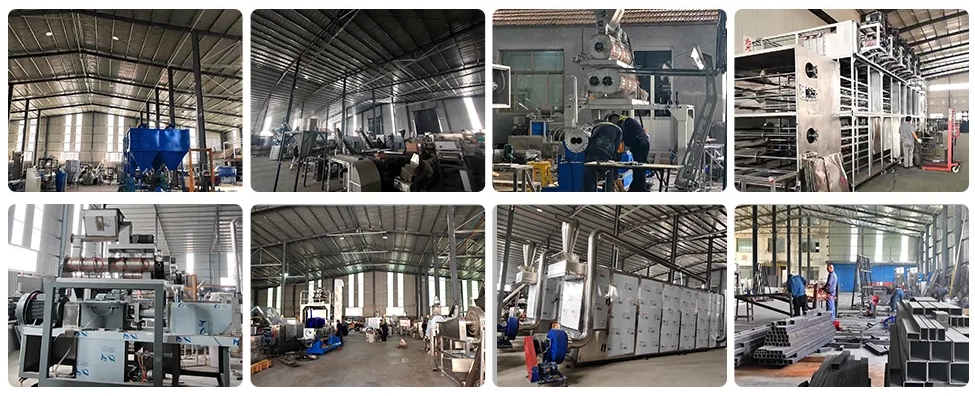
- Blade Design and Noodle Shape: The cross-sectional shape of the noodle is determined by the blade’s edge. A straight, sharp blade creates a square or rectangular noodle. A slightly concave blade can create a noodle with rounded edges. The width of the blade determines the noodle’s thickness.
- The Creation of the Wave: The iconic wavy noodle is not an aesthetic whimsy; it is a feat of engineering. The wave is created by a speed differential: the slitter blades rotate at a faster surface speed than the noodle sheet is being fed forward. This causes the newly cut strands to buckle and fold, creating the uniform waves.
- Functional Benefits of the Wave:
- Prevents Matting: The waves create air pockets, preventing the noodles from forming a solid, dense brick that would be difficult to steam, fry, and rehydrate.
- Increases Surface Area: A wavy noodle has more surface area than a straight one, leading to more efficient moisture removal during drying/frying and faster, more even rehydration in the bowl.
- Sauce and Soup Adhesion: The nooks and crannies of the waves trap soup and sauce, delivering more flavor in every bite.
- Strukturelle Integrität: The folded structure gives the noodle block more mechanical strength, reducing breakage during packaging and transport.
- Functional Benefits of the Wave:
The calibration of the feed speed versus the cutter speed allows the producer to control the amplitude and frequency of the waves—a subtle but important signature of their product.
Pillar 4: The First Transformation: Steaming and Starch Gelatinization
The raw, cut noodles are perishable and inedible. The first step in making them “instant” is to cook them. This is achieved through steaming, a process that fundamentally changes the internal chemistry of the noodle through a process called gelatinization.
The Physics of Steaming
The noodle strands are conveyed through a steam tunnel or cabinet, where they are enveloped in saturated steam at atmospheric pressure (100°C / 212°F). Steam is a highly efficient heat transfer medium; it condenses on the cooler surface of the noodles, releasing a large amount of latent heat directly into them.

The Chemistry of Gelatinization
This applied heat energy triggers starch gelatinization, a phase transition that is critical to the noodle’s edibility and texture.
- Granule Swelling: As the noodle’s temperature rises, the starch granules within the gluten matrix begin to absorb the internal water rapidly.
- Crystallite Melting: The heat disrupts the hydrogen bonds holding the crystalline regions of the starch molecules together.
- Irreversible Expansion: The granules swell to many times their original size, losing their crystalline structure and becoming amorphous. Instant noodle making machine They leach out amylose molecules into the surrounding water.
- Viscosity Increase: The massive, swollen granules and the leached amylose create a thick, viscous gel within the noodle. This sets the noodle’s structure, making it soft and edible.
The Critical Control Parameters of Steaming
The quality of steaming is not binary; it is a spectrum controlled by time and temperature.
- Under-Steaming: If the steaming time is too short or the temperature too low, the gelatinization will be incomplete. The core of the noodle will remain hard and uncooked, leading to a white, starchy “core” and a hard, unpalatable texture even after rehydration. The noodle will also be more fragile.
- Optimal Steaming: The goal is to achieve complete or near-complete gelatinization throughout the entire noodle cross-section. The noodle becomes fully cooked, translucent, and pliable. The ideal steaming time can range from 2 to 5 minutes, depending on the noodle’s thickness and density.
- Over-Steaming: Excessive steam causes the starch granules to break down completely. The noodle becomes overly soft, sticky, and mushy. It may clump together and will not withstand the subsequent frying or drying process, leading to a poor final texture with no bite.
After optimal steaming, the noodle is approximately 60-70% cooked. Its structure is set, its flavor is muted, and it is ready for the decisive preservation step.
Pillar 5: The Preservation Crossroads: Frying vs. Air-Drying
The steamed noodle is cooked but highly perishable, with a moisture content of around 30-35%. To achieve shelf stability, this moisture must be reduced to 8-12%. The method chosen for this dehydration is the most defining characteristic of the instant noodle, creating a fundamental fork in the road between two different product philosophies.
The Flash-Frying Method: Tradition and Texture
This is the classic method that created the global instant noodle industry. The steamed noodle blocks are deep-fried in oil for 60-120 seconds.
- The Process: The noodles are molded into their classic block shape and immersed in hot oil, typically at 140-160°C (284-320°F). Palm oil is the industry standard due to its stability and neutral flavor, but high-quality producers may use canola, sunflower, or rice bran oil.
- The Science of “Puffing”: The intense heat causes the internal water to flash into steam. This water vapor expands rapidly, escaping the noodle and leaving behind a microscopic network of pores and tunnels throughout its structure. This porous, spongelike matrix is the secret to instant rehydration. When hot water is added later, it can penetrate this network almost instantly, rehydrating the starch and recreating a cooked noodle texture in minutes.
- Texture and Flavor Impact: Frying completes the cooking process (the Maillard reaction between sugars and amino acids contributes to flavor and color) and gives the noodle a characteristic rich mouthfeel and a distinct, pleasant oiliness. The fat content of the final block is high, typically 15-20%.
- Challenges: The primary drawbacks are the high fat content and the potential for oil oxidation over time, which can lead to rancidity. The choice of a high-quality, stable oil is therefore critical.
The Air-Drying / Non-Fried Method: The Health-Conscious Alternative
In response to demand for healthier options, air-drying has become a major segment. This is a much more delicate and time-consuming process.
- The Process: The steamed noodle blocks are conveyed through a multi-stage drying tunnel, where controlled temperature, humidity, and airflow slowly remove moisture over a period of several hours.
- Pre-Drying: Lower temperature and higher humidity to remove surface moisture without “case-hardening”—creating a dry crust that traps moisture inside.
- Main Drying: Higher temperature and lower humidity to drive moisture from the core of the noodle block.
- Conditioning/Cooling: A final stage to equalize the remaining moisture and cool the noodles for packaging.
- Science of Slow Drying: The goal is to remove water without causing excessive starch retrogradation (recrystallization), which would make the noodle hard, glassy, and unable to rehydrate properly. The process must be gentle enough to preserve the noodle’s structure without creating the large pores of fried noodles.
- Texture and Flavor Impact: Air-dried noodles have a lower fat content (3-7%) and a denser, more pasta-like texture. They lack the rich mouthfeel of fried noodles and often have a longer rehydration time (4-6 minutes). Their flavor is cleaner, allowing the wheat’s natural taste to come through.
- Challenges: The primary challenge is achieving a texture that is not overly hard or dense. It requires exquisite control over the drying profile. Any inconsistency can lead to cracking, checking (internal micro-fractures), or uneven rehydration.
The Choice:
The decision between frying and air-drying is a statement of intent. Frying prioritizes speed of rehydration and a classic, rich, springy texture. Air-drying prioritizes health credentials and a cleaner, more straightforward wheat flavor. The highest quality can be achieved with either method, but they result in fundamentally different products.
Pillar 6: The Final Act: Cooling, Stabilization, and Packaging
The process is not complete when the noodles exit the fryer or dryer. The final steps are crucial for locking in the quality that has been so carefully engineered.
Cooling: A Non-Negotiable Step
The noodles emerge from the preservation step hot, between 80°C and 100°C (176°F – 212°F). Packaging them at this temperature would be disastrous.
- Preventing Condensation: Hot noodles placed in a sealed package will release moisture vapor as they cool. This vapor will condense on the cooler inner surface of the packaging, creating a wet environment that is a breeding ground for mold and bacteria.
- Stopping Cooked Carryover: The residual heat within the noodle block can continue to cook it slightly, potentially pushing it past its optimal texture. Rapid cooling halts this process.
- Oil Stabilization (for Fried Noodles): For fried noodles, rapid cooling helps the oil on the surface to set, reducing tackiness and making the blocks less likely to stick together.
Cooling is typically done on long, open conveyor belts with ambient or forced-air cooling, bringing the noodle blocks down to within 5°C of room temperature before packaging.
Stabilization and the Maillard Reaction
Even after cooling, chemical reactions can continue slowly. The Maillard reaction, which contributes to color and flavor, can proceed over weeks and months, potentially causing the noodle to darken and develop off-flavors. The low moisture content and, in the case of fried noodles, the antioxidant effect of the oil, naturally slow this process. For air-dried noodles, the absence of oil makes them more susceptible, highlighting the need for perfect initial drying and excellent packaging.
Packaging: The Final Guardian
The package is the final, critical control point. It must be a fortress against the enemies of shelf life: oxygen, moisture, light, and physical damage.
- High-Barrier Materials: Instant noodle packets are not simple plastic bags. They are sophisticated laminates of multiple layers: typically an outer printed layer, a middle layer of aluminum foil or metallized film that acts as a barrier to oxygen and light, and an inner food-grade plastic layer that is heat-sealable. Cup noodles use polypropylene or polystyrene cups with a foil laminate lid.
- Nitrogen Flushing: This is a key technology for quality preservation. Before the packet is sealed, the air inside is evacuated and replaced with pure nitrogen gas. As an inert gas, nitrogen does not support oxidation, preventing the noodle (and its oil, if fried) from becoming rancid. It also provides cushioning, protecting the delicate noodle block from being crushed during transport.
- The Human Element: For small-batch producers, the visual design of the packaging is a primary communication tool. It conveys the brand’s story, its commitment to quality, and the culinary experience within. A well-designed package justifies a premium price and builds consumer trust.
Creating a high-quality instant noodle block is a symphony, not a single note. It is a continuous, integrated process where each pillar supports and influences the others. The choice of flour dictates the dough’s hydration. The developed gluten network must be capable of being laminated and sheeted. The sheeted noodle must have the structural integrity to be steamed without disintegrating. The steamed noodle’s gelatinized starch matrix must be perfectly configured to either puff from frying or dry evenly without cracking.
There is no single secret. The secret is a relentless, scientific, and artistic pursuit of perfection at every single stage. From the wheat field to the sealed package, every decision, every calibration, and every control point contributes to the final moment of truth: when hot water hits the block, and in a few short minutes, transforms a dry, preserved brick into a steaming, aromatic, and texturally sublime bowl of noodles. It is a testament to human ingenuity—a simple convenience, elevated to a craft.







